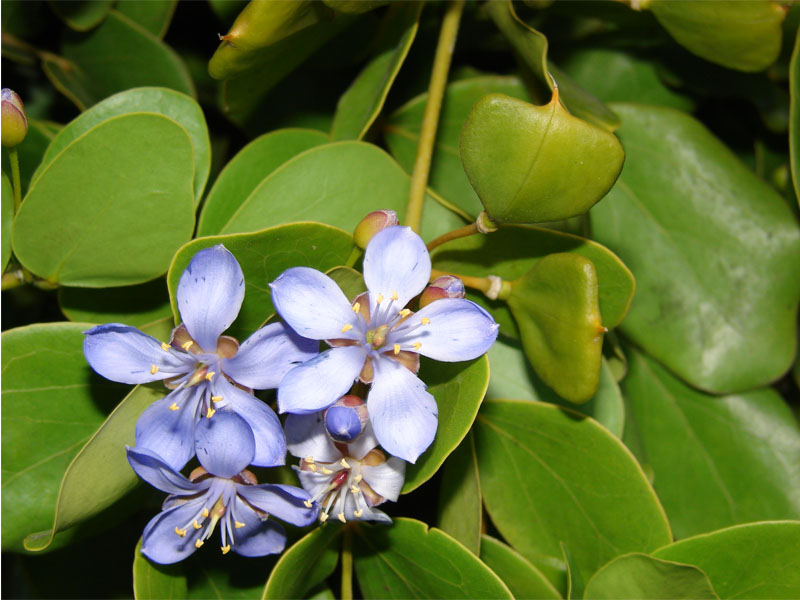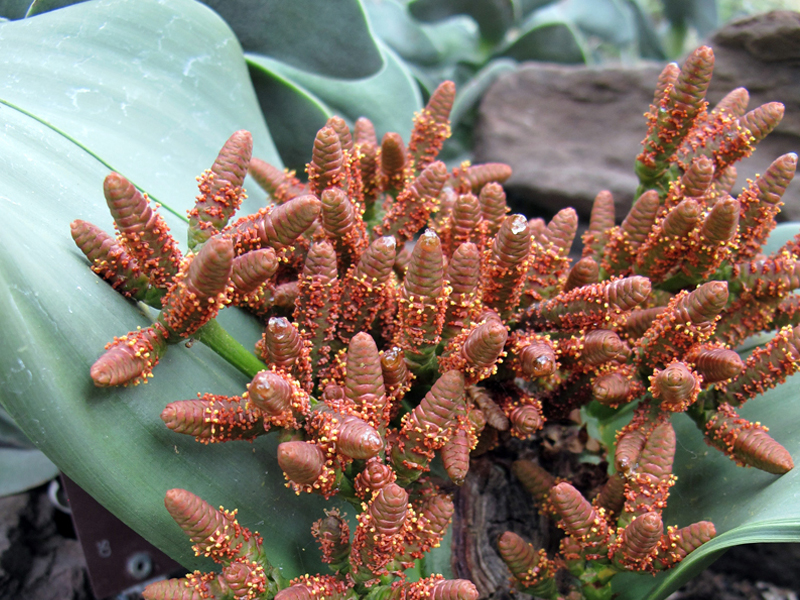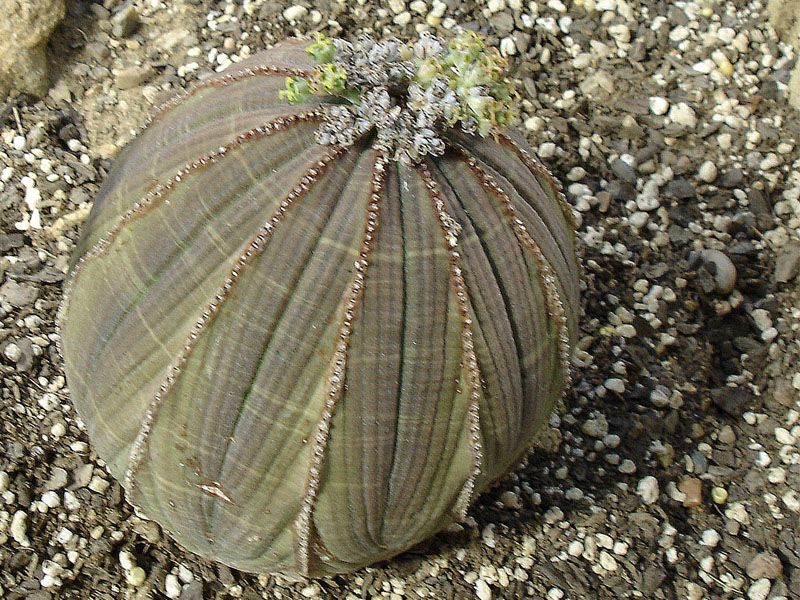The U.S. Botanic Garden maintains more than 12,000 accessions, which equates to about 65,000 plants. These are used for exhibition, study, and exchange with other institutions. The Garden's noteworthy collections include economic plants, medicinal plants, orchids, carnivorous plants, cacti and other succulents, aroids, plants of eastern North America, bromeliads, cycads, and ferns. Historic specimens include several that date from the original 1842 founding of the collection.
While individual plants are the building blocks of exhibits, the plant collection as a whole reflects our institutional history and priorities and supports programmatic goals. The Garden has a noted collection of rare and endangered plants.
Explore a few visitor favorites from our rare and endangered collection:

Tree of life or Lignum vitae
Plant Botanical Name: Guaiacum officinale
USBG Plant Location: Conservatory, Medicinal Plants house
Plant Threat Level: Endangered
Before polymers, alloys and composites, the wood of Guaiacum officinale, also known as tree of life, was extremely important due to its combination of strength, toughness and density. The common name, Lignum vitae (tree of life or wood of life), comes from its historic medicinal use as a remedy for conditions from arthritis to coughs to syphilis. These uses caused over harvesting, reducing native populations to the point that Lignum vitae is now listed as "Endangered" by IUCN (The World Conservation Union). It is native to most of the Caribbean (including Key West), a 'biodiversity hotspot' that supports exceptionally diverse ecosystems. Most of its native habitat has been devastated by deforestation and development.

Onyanga (Desert Onion)
Plant Botanical Name: Welwitschia mirabilis
USBG Plant Location: Conservatory, World Deserts house
Plant Threat Level: Rare
Welwitschia mirabilis grows in isolated communities in the Namib Desert in central Namibia to southern Angola. The plants are seldom found far from the coast, and the distribution coincides with the fog belt. Welwitschia is still somewhat common in its habitat and shows variability, a sign that the species is not near extinction. Although the plant is not endangered, it is protected by law. Rainfall in Welwitschia's natural habitat is erratic and extremely low; often, there are years with no rainfall at all. Welwitschia is ecologically highly specialized and is adapted to grow under these arid conditions in areas that receive regular fog. Welwitschia leaves are formed so that it waters its own roots by collecting condensation, and the leaf surfaces have numerous stomata (microscopicpores) through which condensation is absorbed. Welwitschia also has a long taproot, allowing it to reach water deep underground. Antelope and rhinoceros chew Welwitschia leaves for hydration during times of drought. The cone of the female plant was used as food for people in earlier times; it was eaten raw or baked in hot ashes. The plant's common name is onyanga, which means "onion of the desert."

Baseball plant
Plant Botanical Name: Euphorbia obesa
USBG Plant Location: Conservatory, World Deserts house
Plant Threat Level: Removed from Endangered list
Also known as the baseball plant, Euphorbia obesa is found only in the Great Karoo region of South Africa. Unsustainable harvesting by collectors and plant exporters almost resulted in the plant becoming extinct. As a result, national and international legislation have been enacted to protect the remaining populations. While Euphorbia obesa remains endangered in its native habitat, it has become very common in cultivation. By growing large numbers of this plant, nurseries and botanical gardens have been working to ensure that specimens being traded and sold among plant collectors are not obtained from the wild, thus protecting it for posterity.
![]()
Christmas heliconia
Plant Botanical Name: Heliconia angusta
USBG Plant Location: Conservatory
Plant Threat Level: Vulnerable
Heliconia angusta, known as Christmas heliconia, due to the red and white flowers that usually emerge during the holiday season. Native to southeastern Brazil, this Heliconia is classified as vulnerable by IUCN because its natural habitats have been converted to agricultural purposes. However, the genetic diversity has been preserved through ex situ conservation. The popularity of Heliconia angusta as a tropical garden plant and horticultural specimen has encouraged widespread propagation of this species, so that it is now readily available.

Koki'o ke'oke'o or Hawaiian white hibiscus
Plant Botanical Name: Hibiscus waimeae
USBG Plant Location: Conservatory, Hawaii house
Plant Threat Level: Subspecies Hannerae is federally listed as Endangered
Hibiscus waimeae is endemic to Kauai, occurring in two distinct and isolated populations on opposite sides of the island. Though separated by less than 30 miles, these have evolved to have unique flower and leaf characteristics that distinguish them from one another. Because Hibiscus species hybridize readily, the unique characteristics of Hibiscus waimeae are threatened by cross-pollination with non-native Hibiscus varieties that have been introduced to Kauai for ornamental use. By carefully hand-pollinating and isolating flowers of Hibiscus waimeae, conservationists are able to collect, grow and store seeds that have not been cross-pollinated.

Florida yew
Plant Botanical Name: Taxus floridana
USBG Plant Location: Conservatory, Medicinal house
Plant Threat Level: Critically Endangered
Florida yew is one of the rarest trees in the world and occurs only in forested bluffs and ravines scattered along a 15-mile section on one side of the Apalachicola River in Florida's Gadsden and Liberty counties. Many of the plants are found on privately owned land, and are vulnerable to destruction because endangered species laws do not protect endangered plants on private property. Like Pacific yew (T. brevifolia), the bark of Florida yew contains the promising cancer-fighting compound taxol. Scientists at Florida State University in Tallahassee were the first to synthesize taxol and the same year, scientists from Montana State University discovered that taxol is produced by a fungus that grows in association with yew trees. Taxol has been proven useful in treating breast cancer, ovarian cancer, some kinds of leukemia and certain kidney diseases. The still-undiscovered pharmaceutical uses of plants are an important reason for plant conservation efforts.

Yellow coneflower
Plant Botanical Name: Echinacea paradoxa
USBG Plant Location: gated outdoor gardens, Pollinator Garden
Sunlight: Full sun
Plant Soil Type: Adaptable to clay, shallow, rocky and dry soils
Plant Moisture Requirements: Low
Plant Threat Level: Vulnerable (NatureServe)
This yellow coneflower, native west of the Mississippi River from Missouri down to Texas, is easy to grow in most well drained garden sites. It typically reblooms with out deadheading, although will self-seed when spent flowers are left in place. The erect seed heads are attractive and prove inviting to goldfinches and other birds throughout the winter.